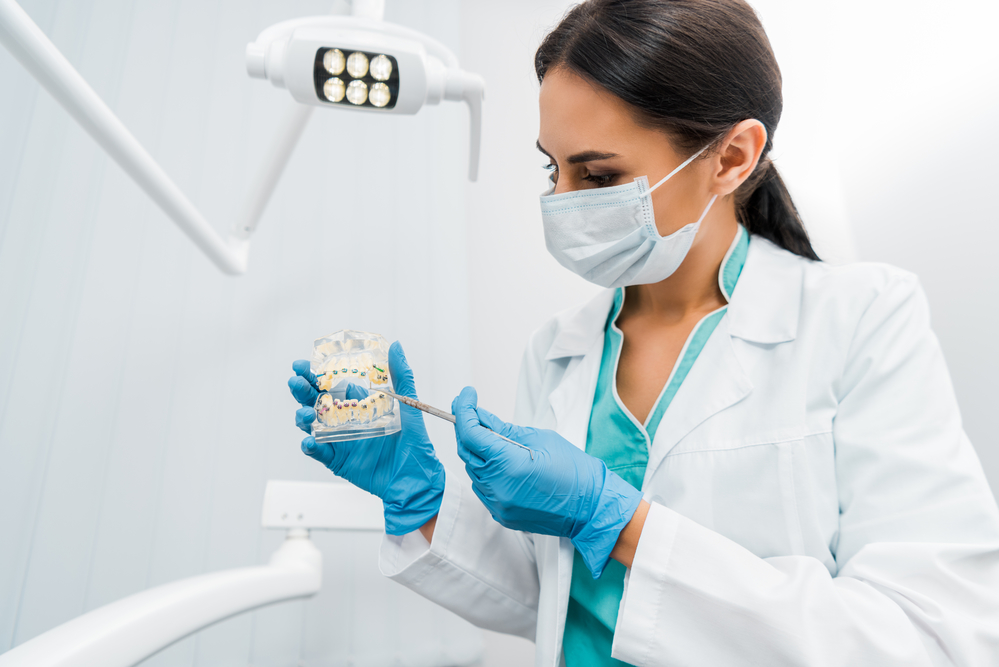
Orthodontists and dentists have been seeing an increase in potential patients with advanced dental work including crowns, implants, and even veneers. Fortunately, teeth can still be straightened for both adults and children if you have one of these additional treatments already in place.
Healthy teeth can be moved at any age, and braces can transform anything from mild crowding and complex bite problems to severely crooked teeth.
Braces After Dental Implants
A dental implant cannot be moved once it has been placed. However, as long as your implant is already in the correct position, the surrounding teeth can be moved and shifted into alignment. Even if you have several implants, orthodontic treatment is still a possibility for straightening your smile.
If your dental implant was not placed in the ideal position and it will look out-of-place once your other teeth are aligned, you could consider replacing it at the end of your orthodontic treatment. This type of replacement doesn’t mean a complete overhaul. Many times replacing just the crown is all that is needed.
Braces Before Dental Implants
Ideally, it is best to carry out orthodontic treatment first before having a dental implant procedure completed. Having braces before dental implants will allow for your orthodontist to ensure your teeth are in the perfect position once your treatment and implant are completed.
For some patients, orthodontic treatment can be a necessity before an implant is able to be placed. Creating enough space for the new tooth and even moving the roots of the neighboring teeth into the correct position can allow for a proper implant.
Braces With Missing Teeth
Children who have malocclusions that can affect their jaw growth or the eruption of their adult teeth often have orthodontic treatment at a young age. Braces and spacers are used to correctly space remaining teeth to allow room for adult tooth eruption. Sometimes, that treatment is necessary in order to make room for adult teeth to come in at all. Severe malocclusions can prevent adult teeth from erupting, so braces are necessary for proper development.
For adults, getting braces with missing teeth can be equally important. A missing adult tooth can cause the remaining teeth to shift, change your bite, cause bone loss, and cause unnecessary strain and wear on your remaining teeth and jaw joint. Braces will enable the space to hold until an implant can be adequately placed after orthodontic treatment.
Braces With Fillings or Crowns
Dental crowns are used as a way to cover teeth that have decayed and cannot be filled. Crowns are also used to repair a chipped or broken tooth, or a tooth that has had to have a root canal. Dental patients with one or more crown are still eligible for braces. Your trained orthodontist will utilize a different type of adhesive when attaching brackets to teeth that have crowns. Apart from the type of adhesive used to secure brackets, the orthodontic treatment is the same as it is on natural teeth.
Braces With Veneers
Veneers are thin layers of porcelain or compounds that are adhered to the front of the teeth to hide spacing issues, chips or stains on the surface of the teeth. If you find your smile could benefit from a combination treatment of both braces and veneers, we recommend braces as the first step. While not always the case, attaching the brackets of braces to veneers could damage the surface of the veneer. The strong adhesive used to hold the brackets in place may leave behind rough spots on the veneer when the braces are removed.
Achieving the Perfect Smile
Don’t let crowns, fillings, dental implants, or veneers stand in your way of achieving a perfect smile and healthier teeth. Thomas Orthodontics is here to help if you have more complex dental work and would like a personal evaluation to see if braces can straighten your smile. Are you ready to learn about how orthodontic treatment can revitalize your life with a new smile? Schedule a free consultation appointment with Thomas Orthodontics today!





